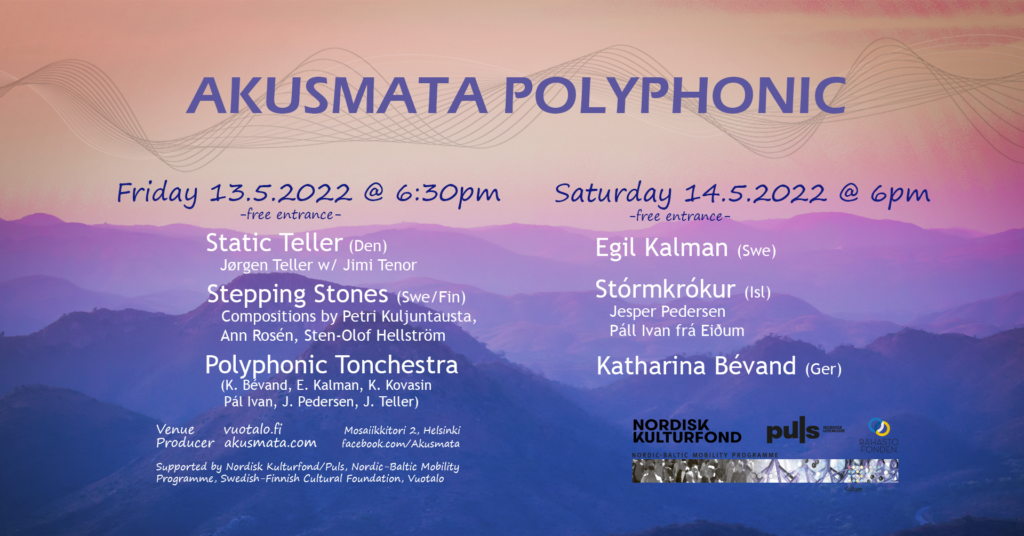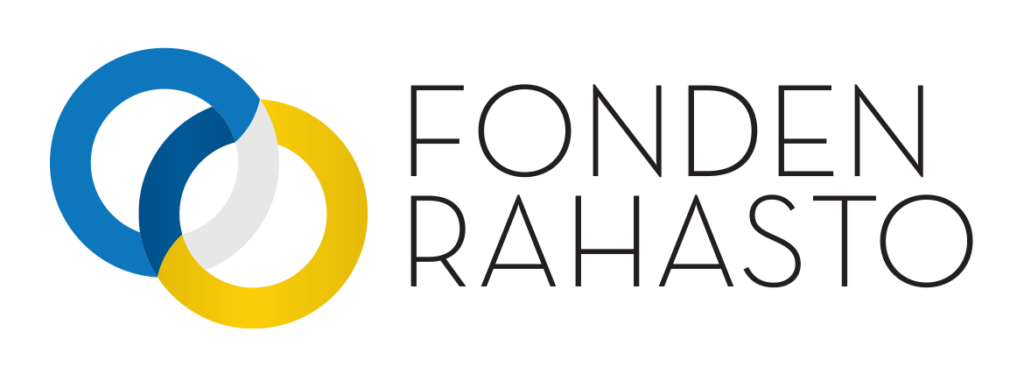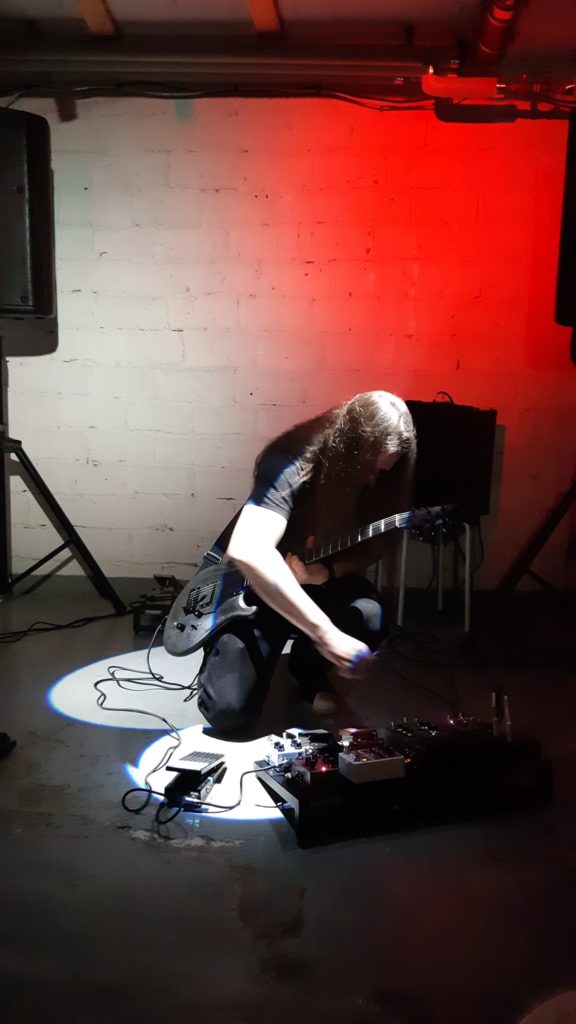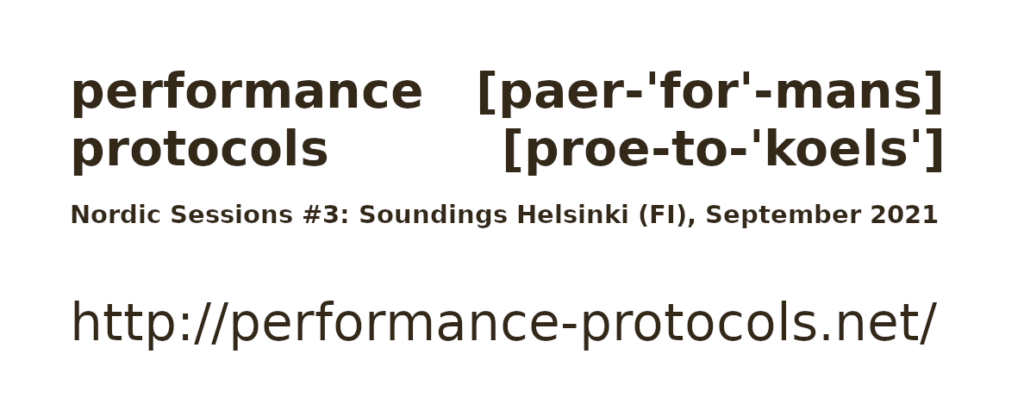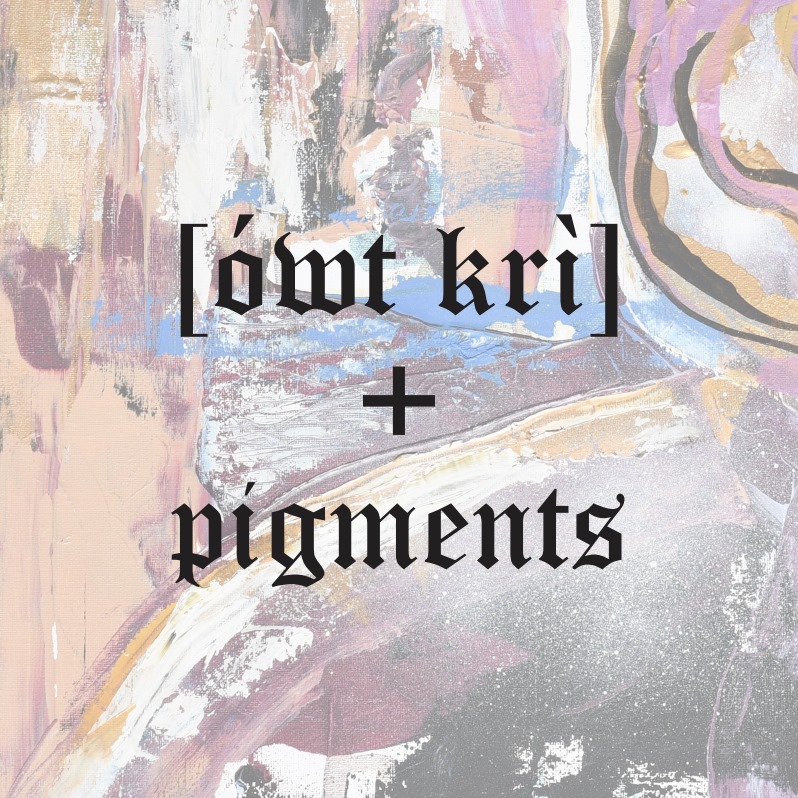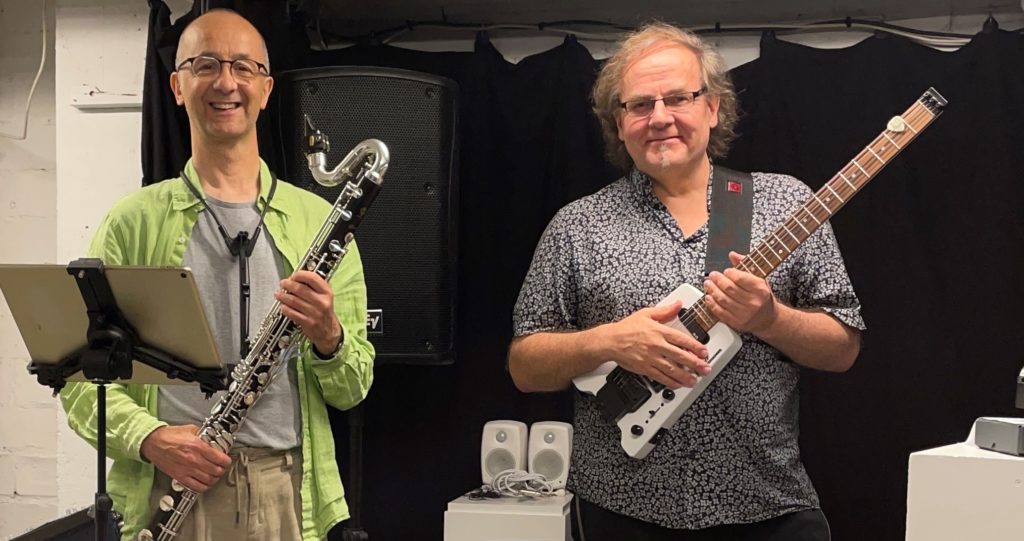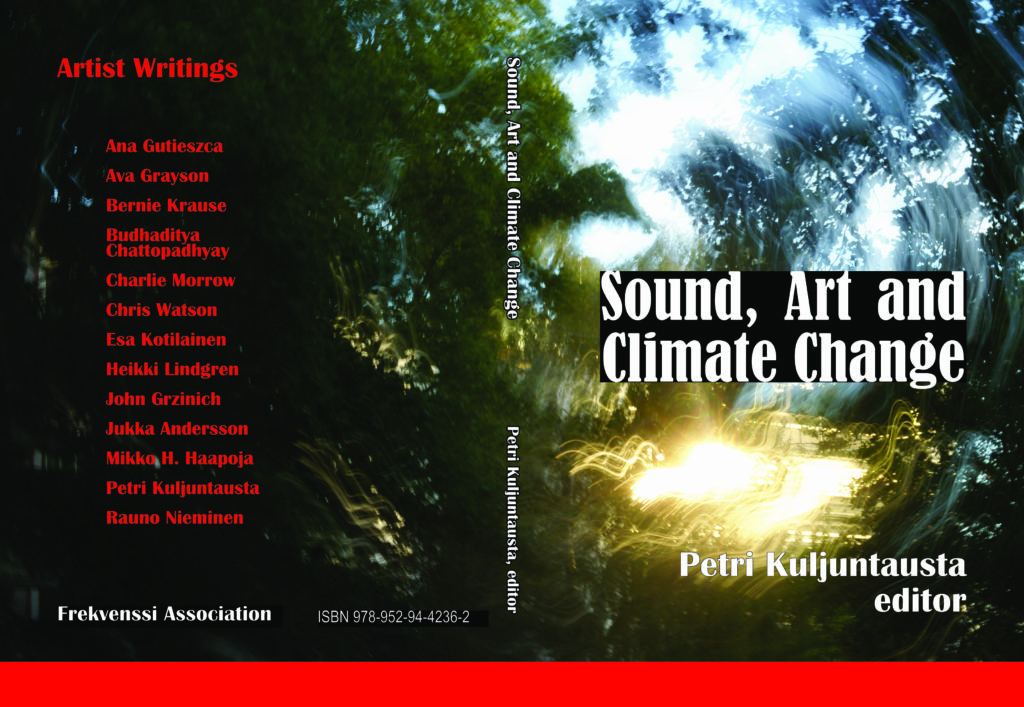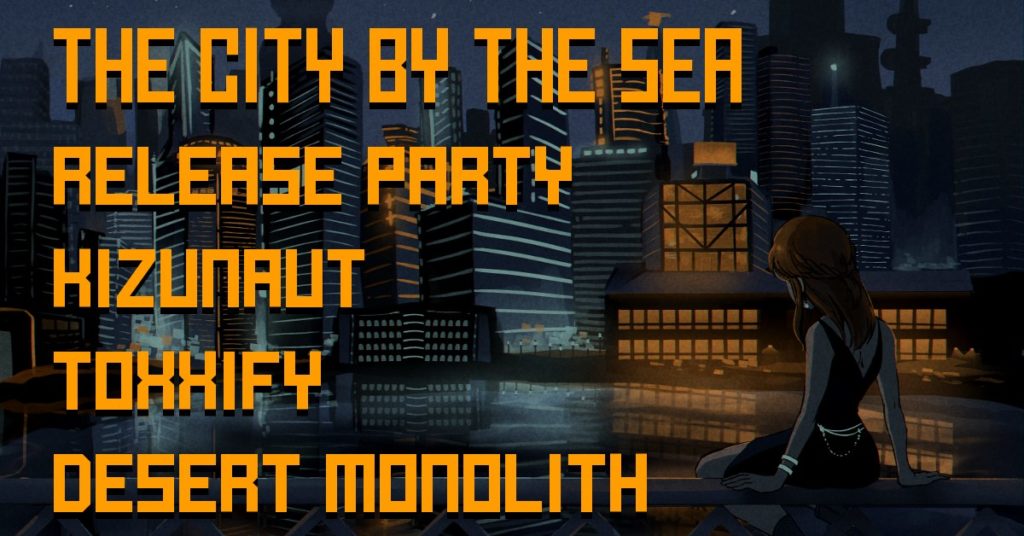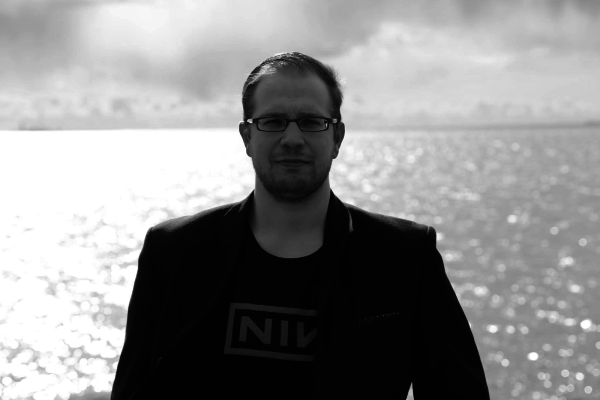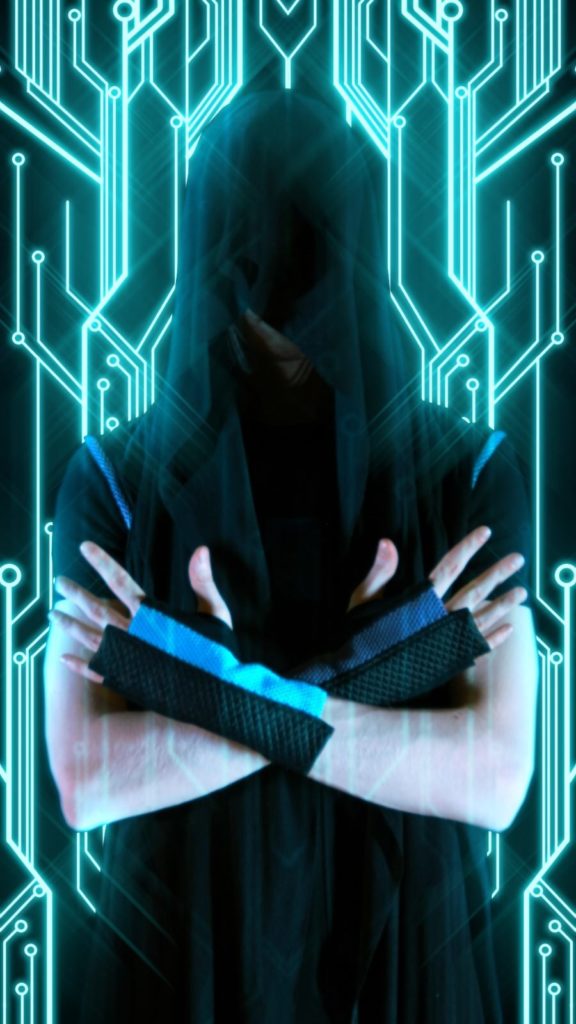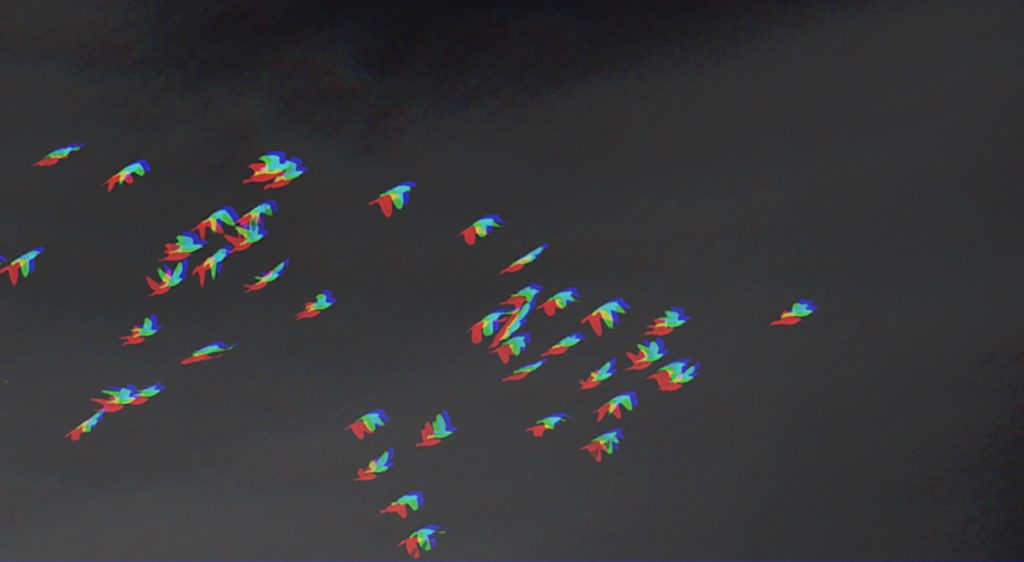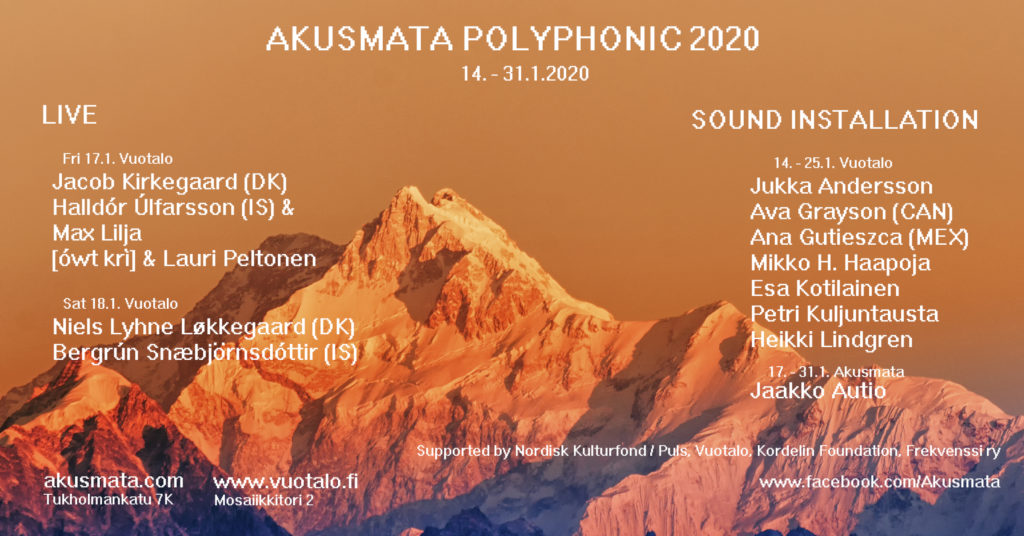AKUSMATA POLYPHONIC 2022
Venue: Vuotalo Cultural Centre, Helsinki
13.–14.5.2022
AKUSMATA POLYPHONIC is an intensive sound art and electronic music event at Vuotalo Cultural Centre in Helsinki. Invited musicians, composers and sound artists are from Nordic countries, Germany and Finland, offering for the audience a wide spectrum of new sonic expression from the fields of experimental electronic music, sound art, noise and ambient. The program includes modular sound systems, do-it-yourself musical instruments, and improvised music with attitude.
 Akusmata Polyphonic 2022 (images by Fredrik Willberg)
Akusmata Polyphonic 2022 (images by Fredrik Willberg)
CONCERTS I – II – III
Friday 13.5.2022 at 18:30
Place: Vuosali (Vuotalo), Mosaiikkitori 2, Helsinki
-free entry-
Performers:
STATIC TELLER (Den)
(Jørgen Teller w/ Jimi Tenor)
STEPPING STONES (Swe / Fin)
(Compositions by Ann Rosén, Sten-Olof Hellström, Petri Kuljuntausta)
POLYPHONIC TONCHESTRA (Fin/Swe/Isl/Den/Ger)
(K. Bévand, E. Kalman, K. Kovasin, Pál Ivan, J. Pedersen, J. Teller)
CONCERTS IV – V – VI
Saturday 14.5.2022 at 18:00
Place: Vuosali (Vuotalo), Mosaiikkitori 2, Helsinki
-free entry-
Performers:
EGIL KALMAN (Swe)
STÓRMKRÓKUR (Isl)
(Jesper Pedersen and Páll Ivan frá Eiðum)
KATHARINA BÉVAND (Ger)
Supported by Nordisk Kulturfond / Puls, Nordic-Baltic Mobility Programme, Swedish-Finnish Cultural Foundation, and Vuotalo Cultural Centre.
Venue
Vuotalo Cultural Centre
Mosaiikkitori 2, 00980 Helsinki
http://www.vuotalo.fi/en/about-us
Akusmata (producer)
galleria.akusmata@gmail.com
akusmata.com
Tukholmankatu 7 K, 00270 Helsinki
ARTISTS
STATIC TELLER (Den)
Call it minimal rock goes synth’n’poetry!
STATIC TELLER is Jørgen Teller’s new solo project, but at the Akusmata Polyphonic Festival it expands into a duo as Jimi Tenor joins in. Teller has a long career as electric guitarist, electronic musician, vocalist and since 1990s he has released many records as solo artist and with Jørgen Teller & The Empty Stairs. Teller has co-labed / performed with many Danish and international musicians like Rhys Chatham, Otomo Yoshihide, Kasper Toeplitz, Jimi Tenor, Kim Cascone, Fast Forward, Jakob Draminsky, David (Pere Ubu) Thomas & foreigners, Coal Hook (w Ron Schneiderman (Sunburned)), Jean-Francois Pauvros, Sofia Härdig, Lazara Rosell Albear, Bruno Ferro Xavier da Silva… At Vuotalo’s concert, STATIC TELLER’s performance will be complemented by video projection. http://www.jorgenteller.dk/STATICTELLER.html
STEPPING STONES (Swe/Fin)
“… a magical experience, (it) breaks all barriers, it’s venturing, it’s experimental and when you open your ears, it is very appealing”, said an enthusiastic critic about a concert of The Barrier Orchestra. Three members of the orchestra, artist Ann Rosén and composers Sten-Olof Hellström and Petri Kuljuntausta, continue their collaboration by launching a new group project. STEPPING STONES is a trio which works as test lab for the musicians focusing on the new interfaces and ways of producing sound in unconventional ways. In the new work series, they combine vivid sound elements and textures into a multi-layered and vibrant whole in an elastic small group format. ANN ROSÉN’s works have been performed at the Swedish Royal Opera, Moderna Museet, and South Bank in London. In the Drawing Sessions by Rosén, she performs with the pencil as her instrument, live electronic music emerge when graphite fuses with paper. STEN-OLOF HELLSTRÖM obtained a PhD in composition at University of Huddersfield, UK. His albums Sine Cera (w/ Bowers) and Kept in the Dark (Agaig) were nominated for best experimental album at the Manifest Awards. PETRI KULJUNTAUSTA divides his time between composing, performing, building sound and media installations, and researching. In recent years, he has done underwater concerts and installations and given concerts with birds.
POLYPHONIC TONCHESTRA
Modular, electronic, analog, improvisation, digital, interactivity, composition, graphic, drone, ambient, do-it-yourself, experimental, synthesizers, electroacoustic, electric guitar, silence, rock, modulation, noise, live processing, feedback… This multinational orchestra offers sound adventures that cannot be known in advance. The orchestra plays on the edge of time and space, its musicians react to what they hear, go further and the performance develops in a direction that cannot be predicted. The journey into the unknown goes through situations where the presence of harmony and chaos is transformed into a musical play in the hands of musicians, where logic and illogicality lose their meaning. Dropping a pebble in water produces essentially the same rippling sound effect as colliding super-black holes a billion light years away in time and space. It partially suggests the elemental power of sound, linked as it is to movement, a signal of life, dynamism and creation. That is what POLYPHONIC TONCHESTRA is all about. At this concert the line-up is K. Bévand, E. Kalman, K. Kovasin, Pál Ivan, J. Pedersen, and J. Teller.
EGIL KALMAN (Swe)
Egil Kalman is a Swedish musician / composer primarily playing modular synthesizer and double bass. His music aims to dissolve the brittle barriers separating traditional Scandinavian folk and contemporary electroacoustic music via minimalist compositional techniques and soulful improvisations. Utilizing just intonation tunings, hypnotic forms, synthesized sound mimicking the acoustic and vice versa, his music explores qualities intrinsic to traditional Scandinavian folk music in ways where the musical foundation is felt rather than explicitly heard. Kalman’s new album ‘Kingdom of Bells – Egil Kalman plays the Synthi 100’ will be realeased in May 2022 on iDeal Recordings: “Mind altering just tuned drones with melodies that echoes traditional Scandinavian folk music flow into abstract soundscapes reminiscent of early electronic music pioneers, but still holds a fresh sound and vibe. Deep synth music from the North!” http://egilkalman.com/
STÓRMKRÓKUR (Isl)
STÓRMKRÓKUR is an electronic duo founded by composers Jesper Pedersen and Páll Ivan frá Eiðum. The music of STÓRMKRÓKUR is seeking new inspiration in techniques used by noise musicians of yesteryear using non-linear feedback through analog sound equipment like mixing desks, stomp boxes and modular synthesizers. The sound world is raw and abstract sounding but with clear dialogues emerging between the sounds walking the fine line between chaos and order. Composer and sound artist Pedersen has written music for acoustic instruments and the electronic medium both, as an electronic musician and improviser he works with diverse groups ranging from contemporary, experimental and improvised music to ambient and drone. Páll Ivan is a multi-instrumentalist and visual artist, he has collaborated in many diverse projects and appears on recordings with baroque music over pop to metal and contemporary experimental music. <https://jesperpedersen.bandcamp.com>, <https://www.pallivan.is>
KATHARINA BÉVAND (Ger)
Katharina Bévand is a sound artist based in Berlin. She performs on modular synthesizers and creates site-specific sound installations and sound sculptures. Bévand works with processed field recordings, extended recording techniques and the resonance of spaces and objects. She exhibited internationally in Germany, Egypt, Taiwan, and in the Autonomous Region of Kurdistan in Northern Iraq. In 2021 she received a research grant from the Berlin Senate and a GVL Stipend for music production, and was part of Goldrausch Project for women artists. She has been a directive board member of the Berlin Association for New Music, BGNM e.V. https://katharinabevand.com/

